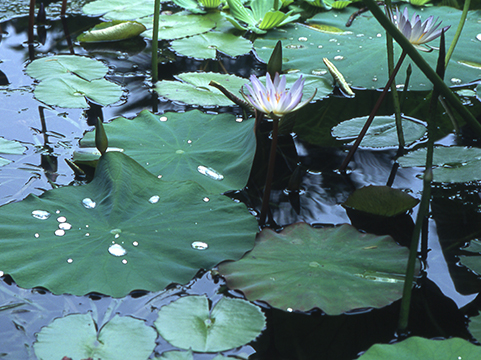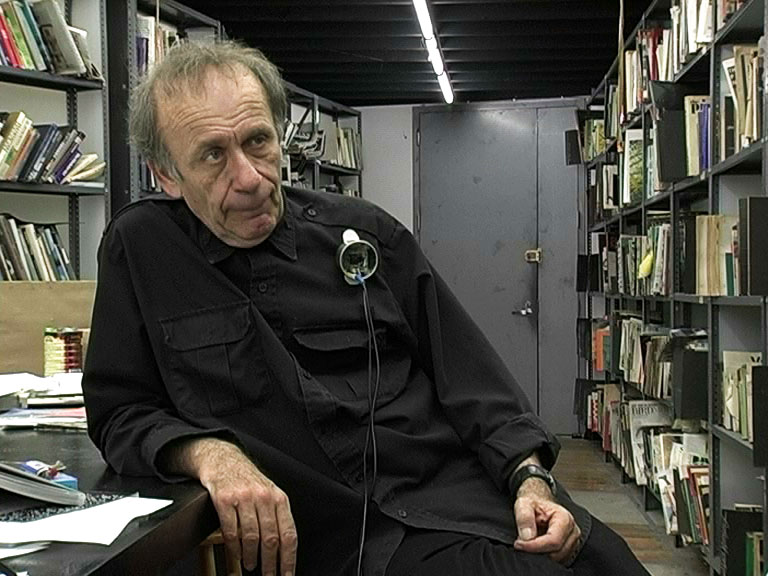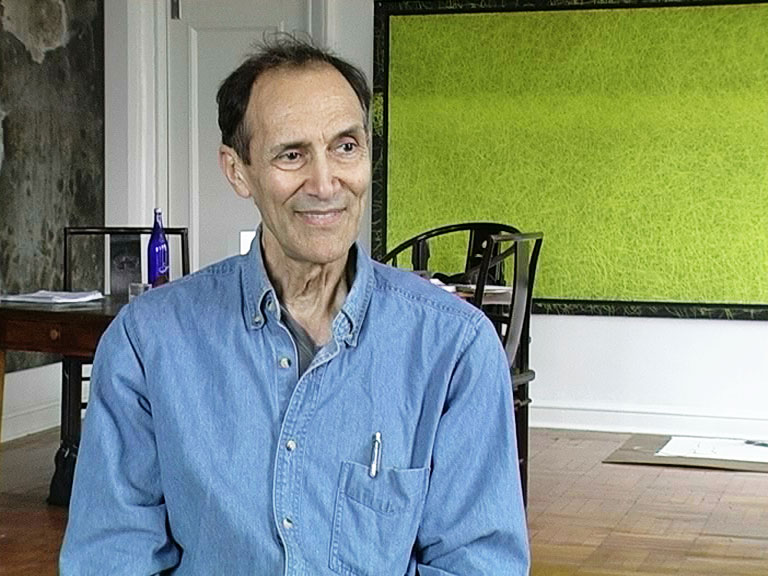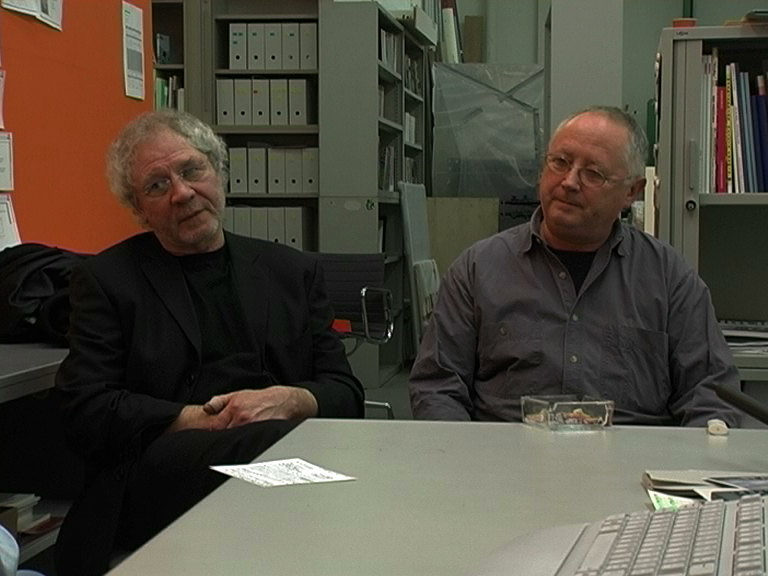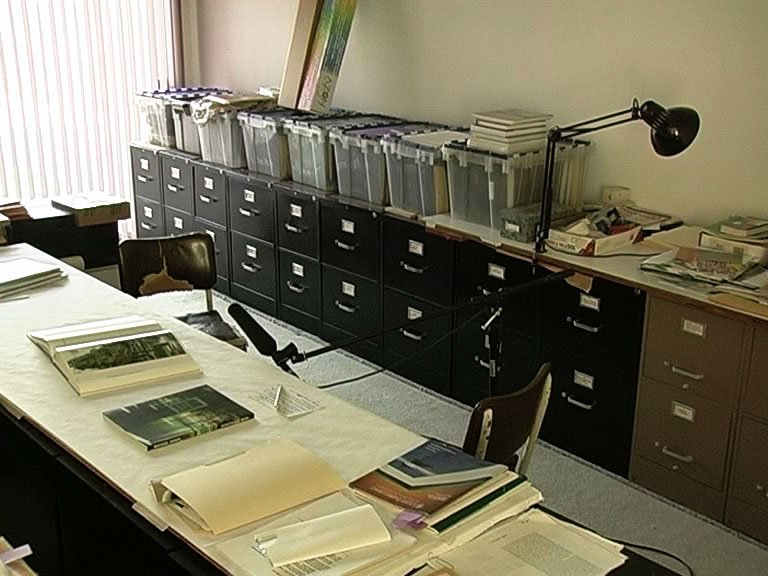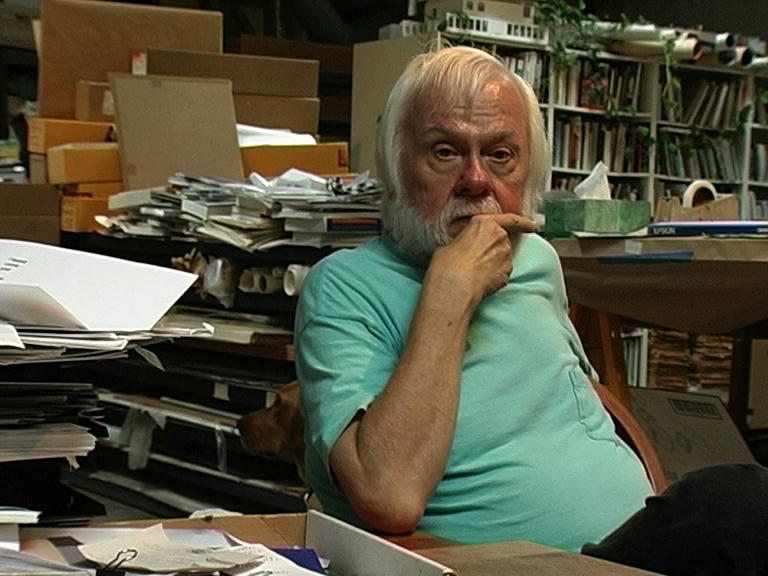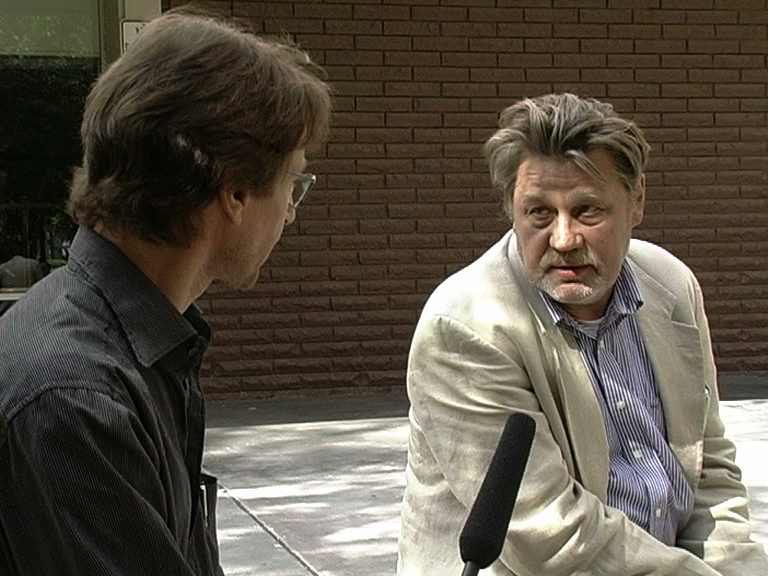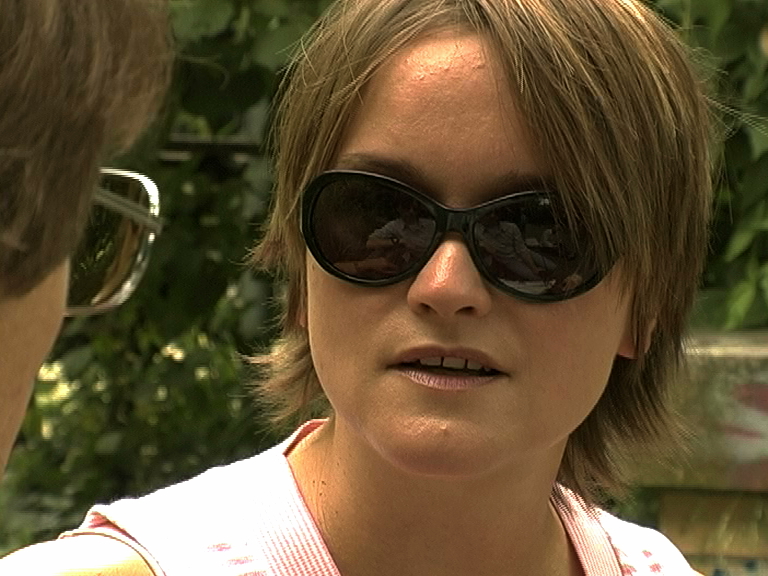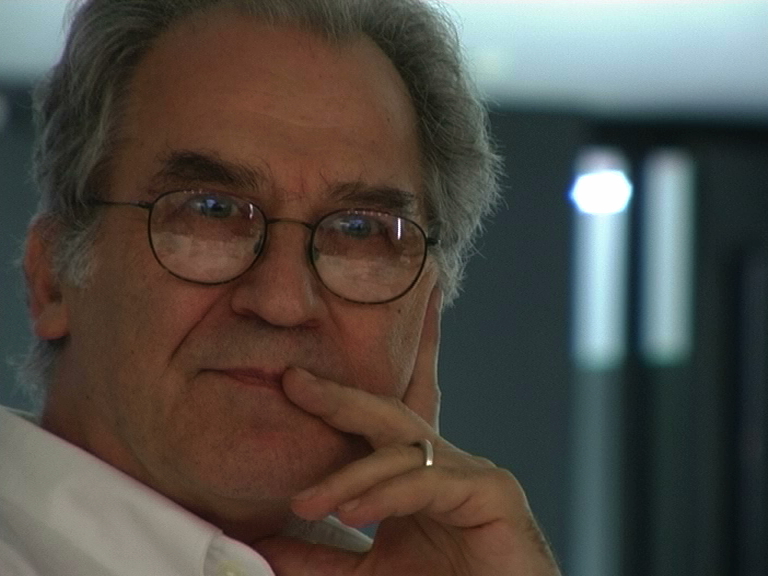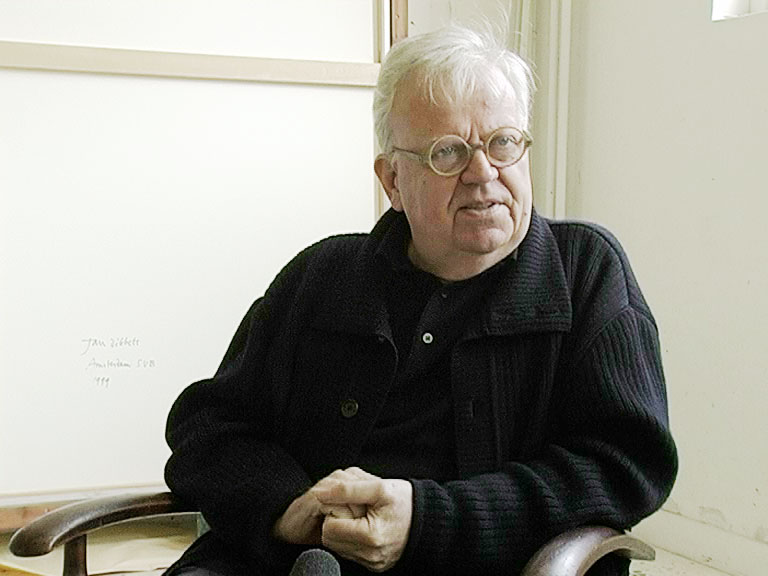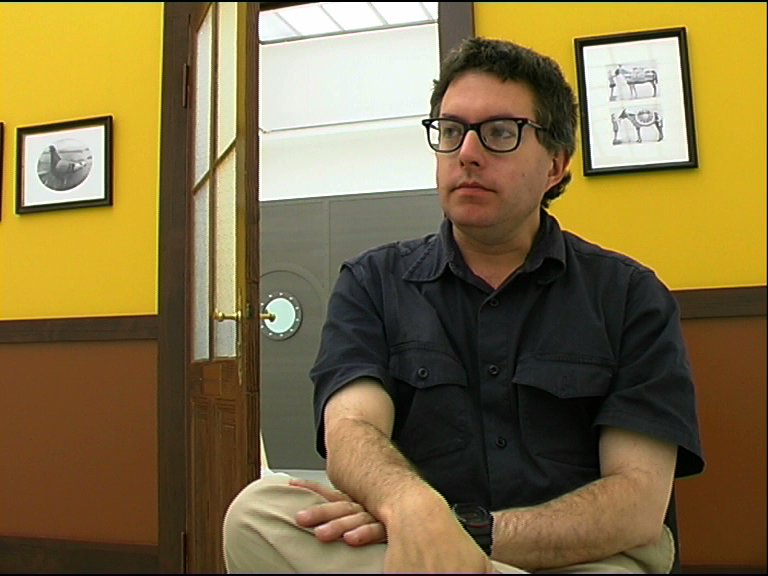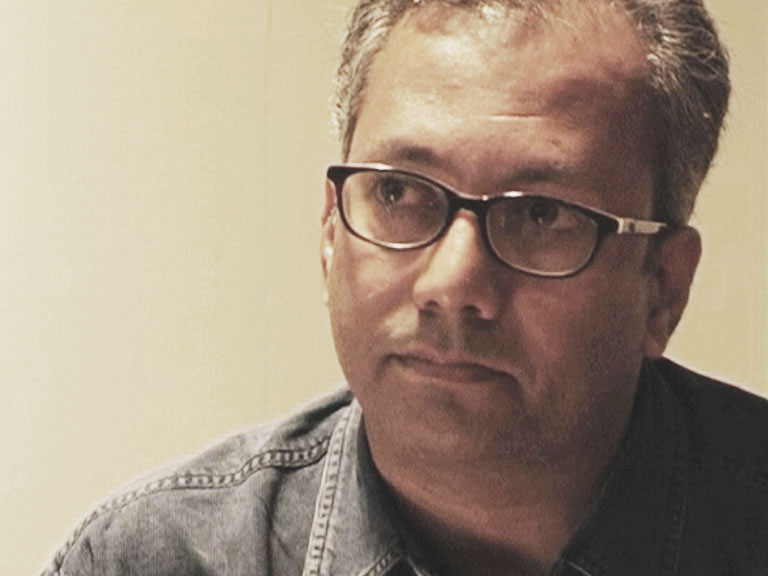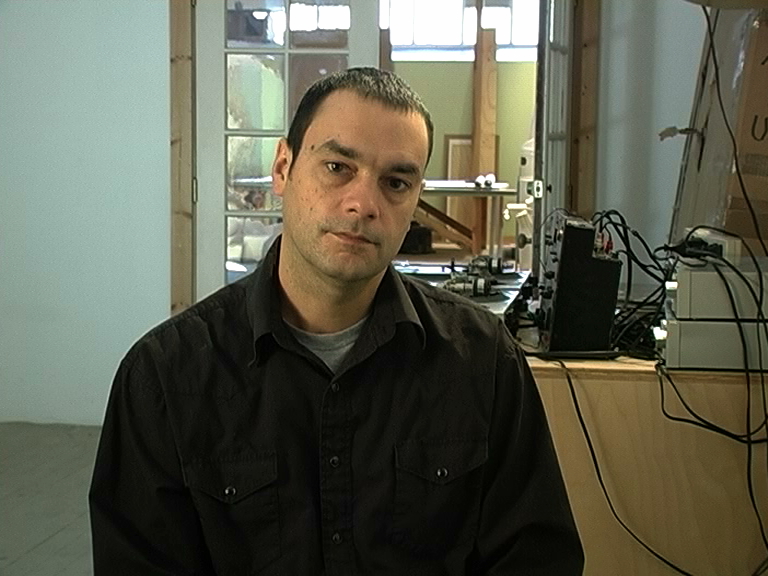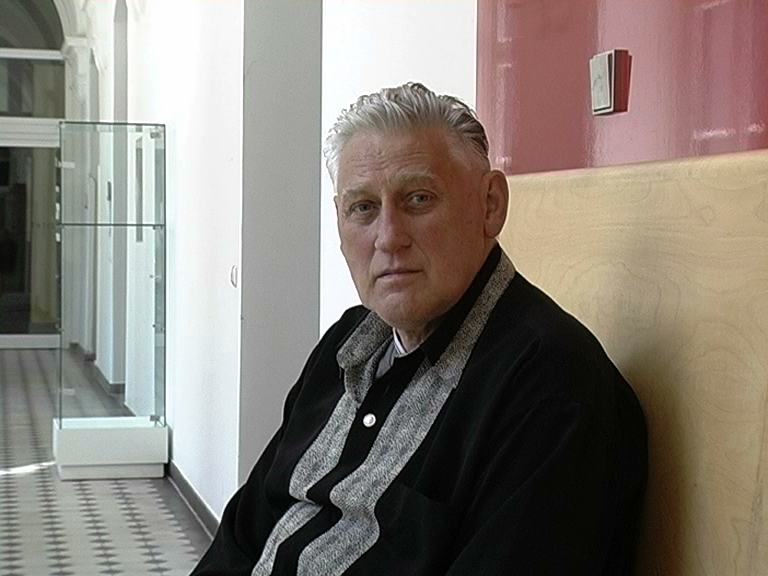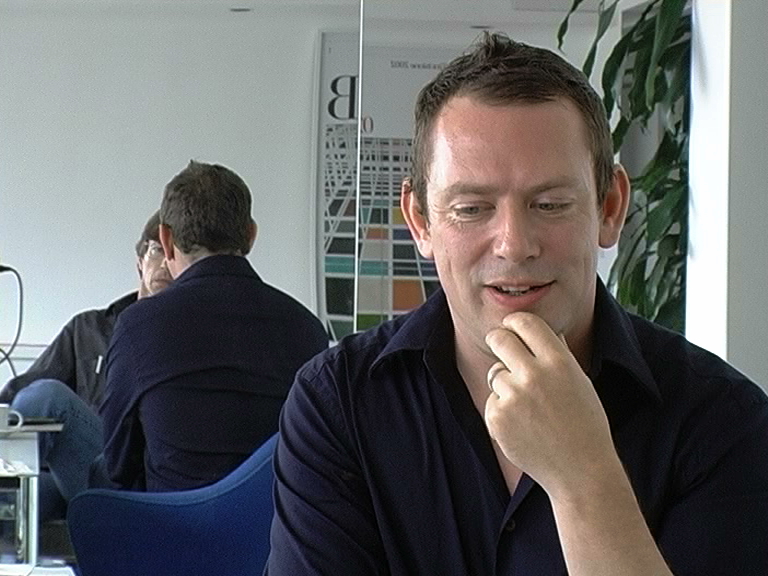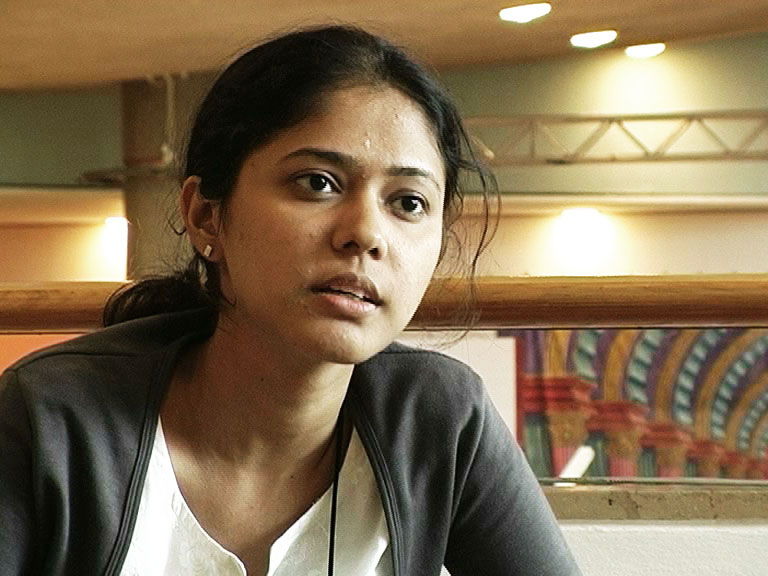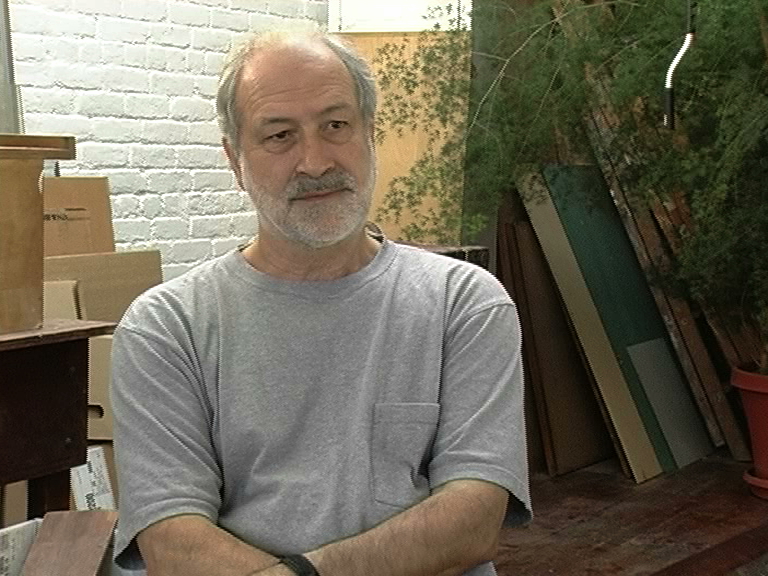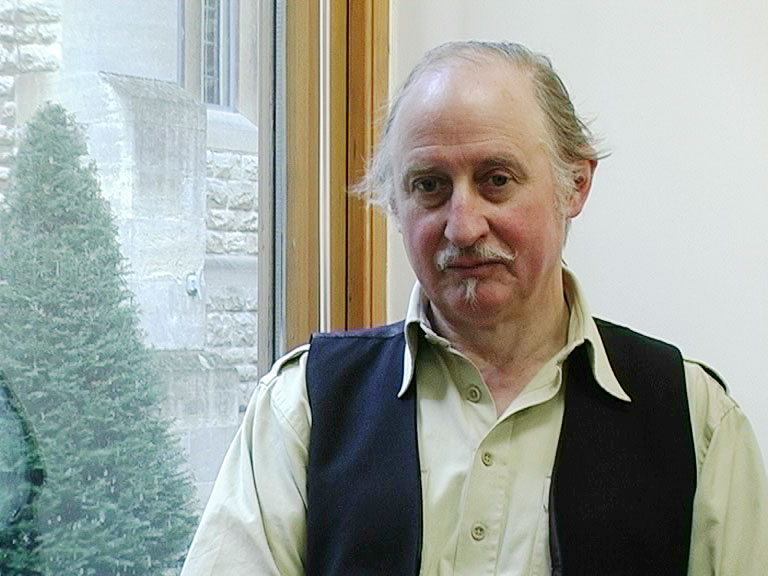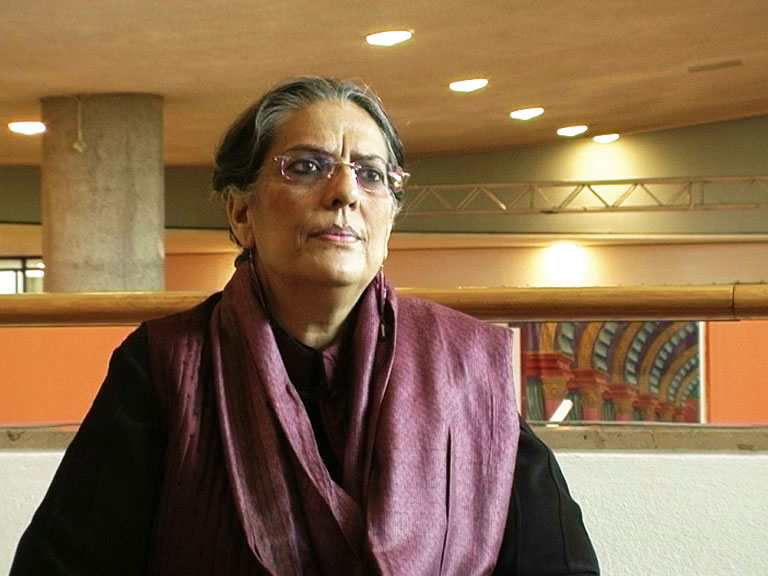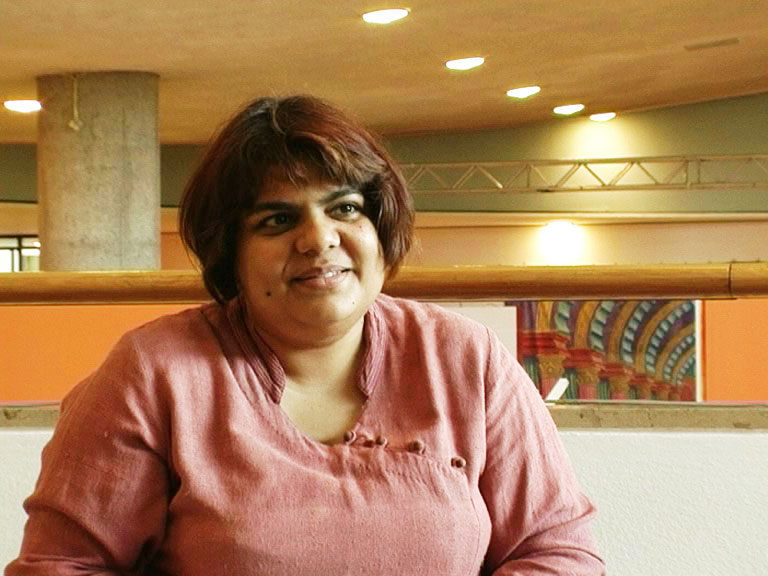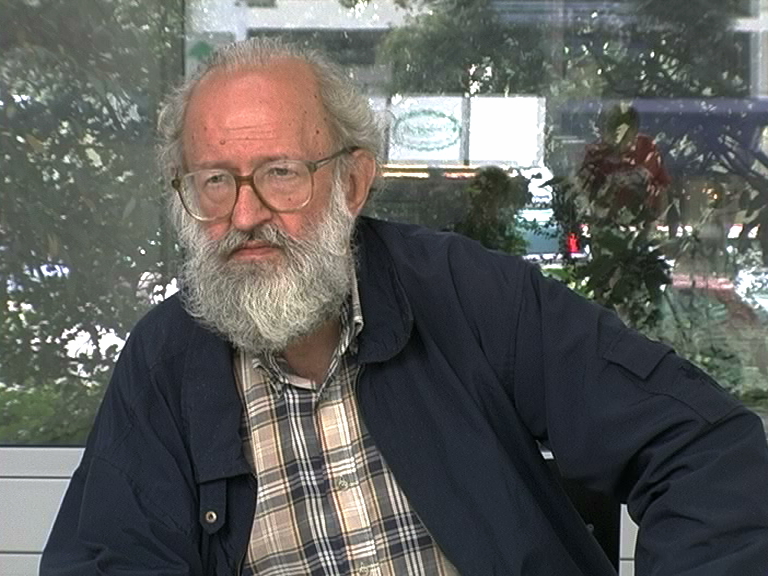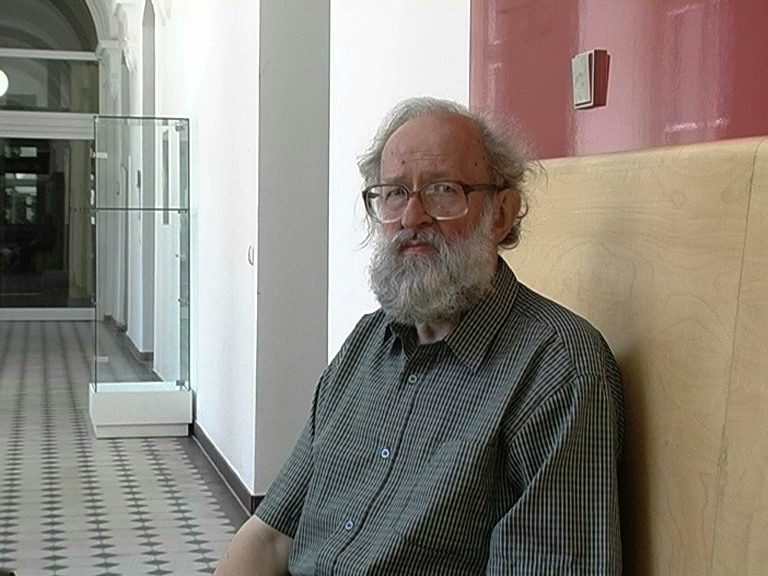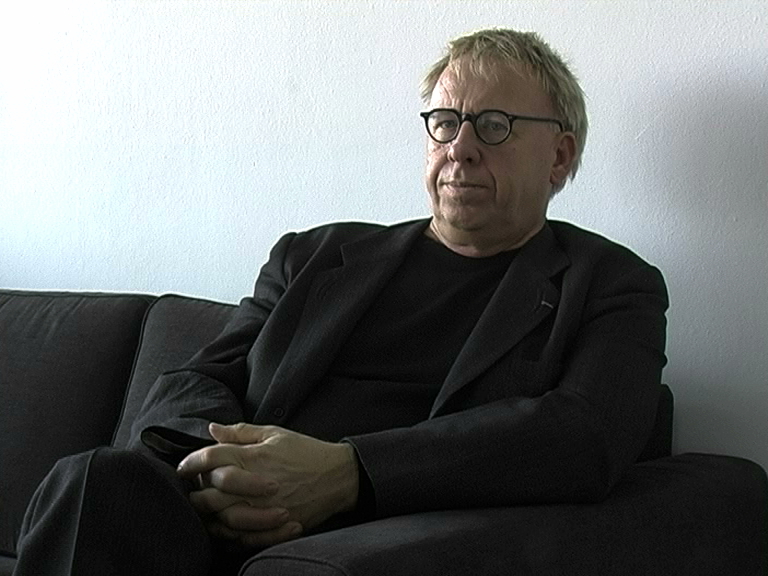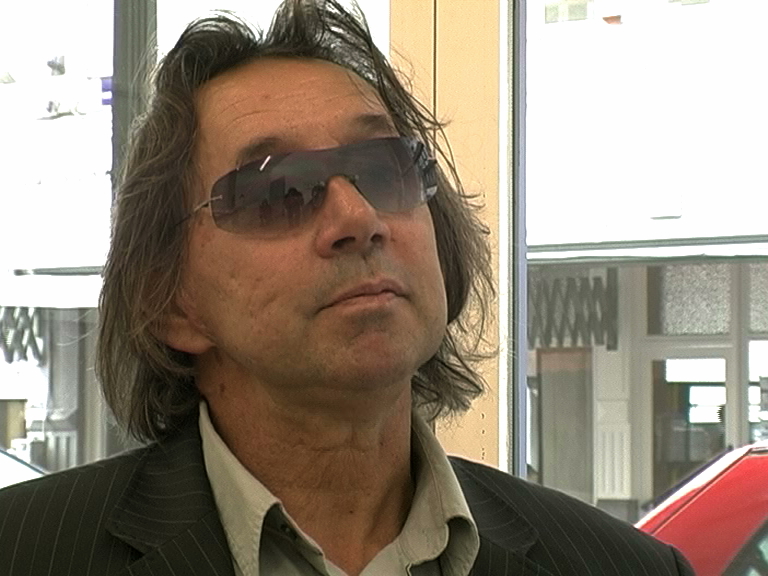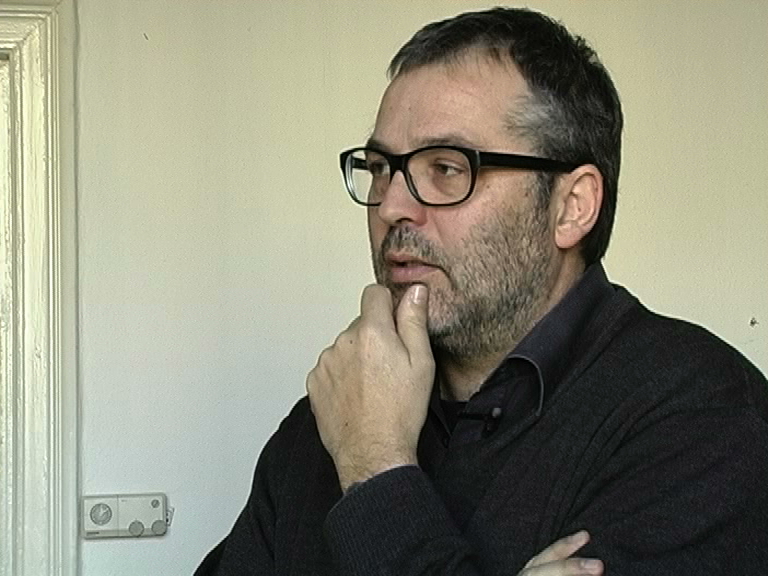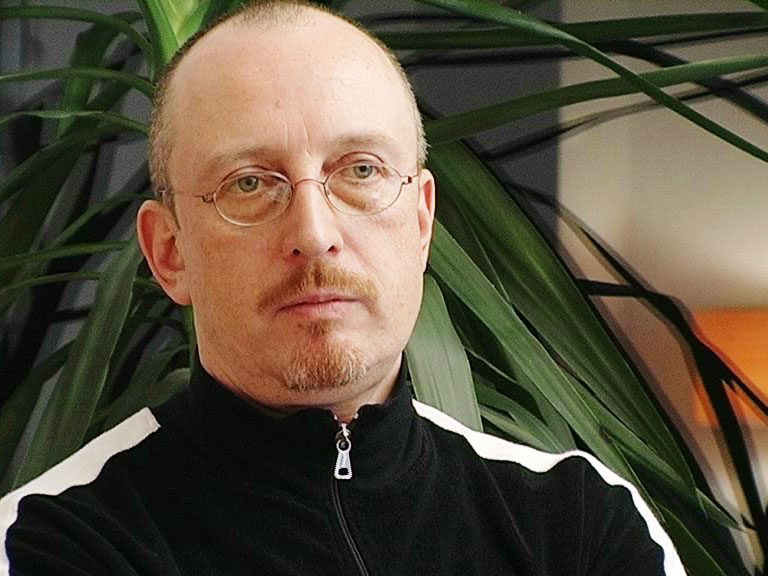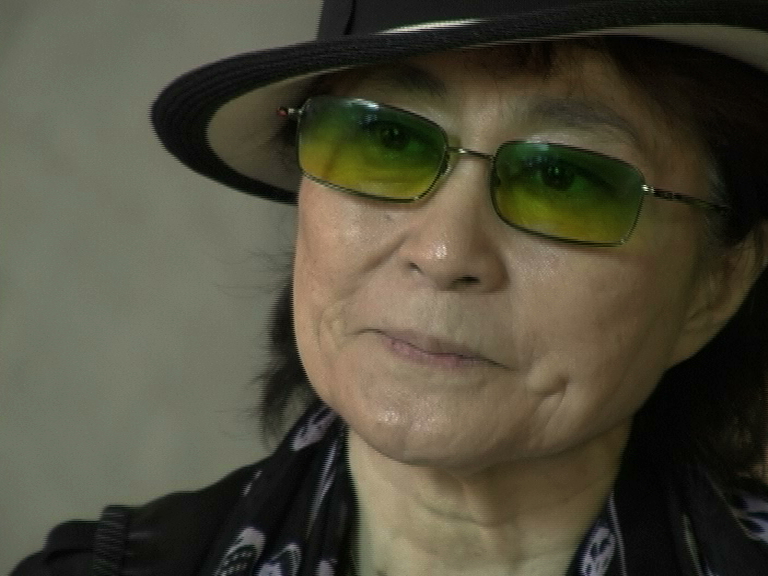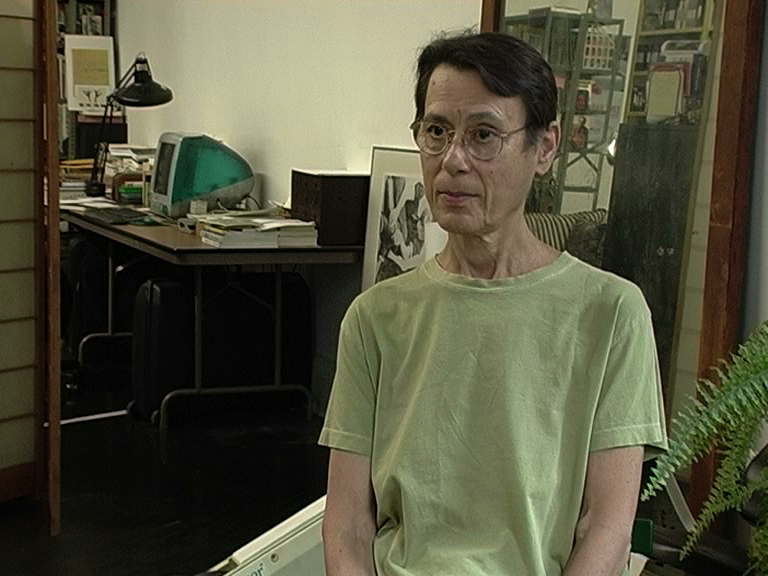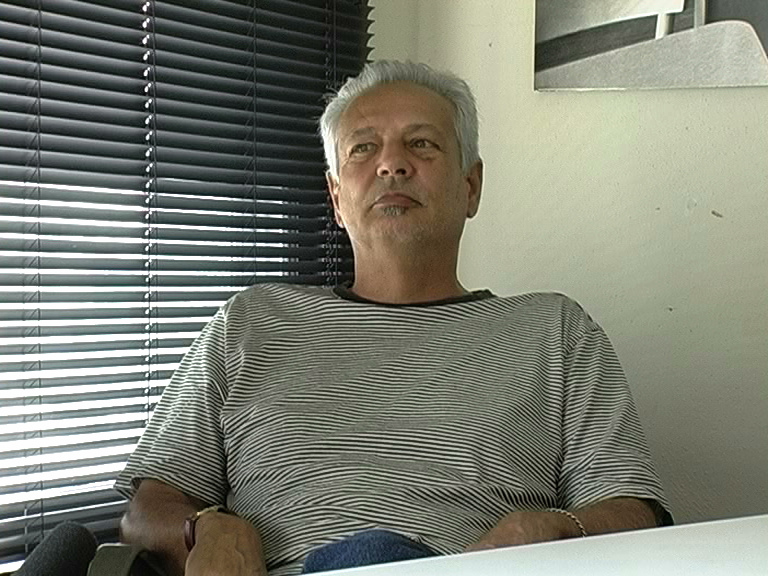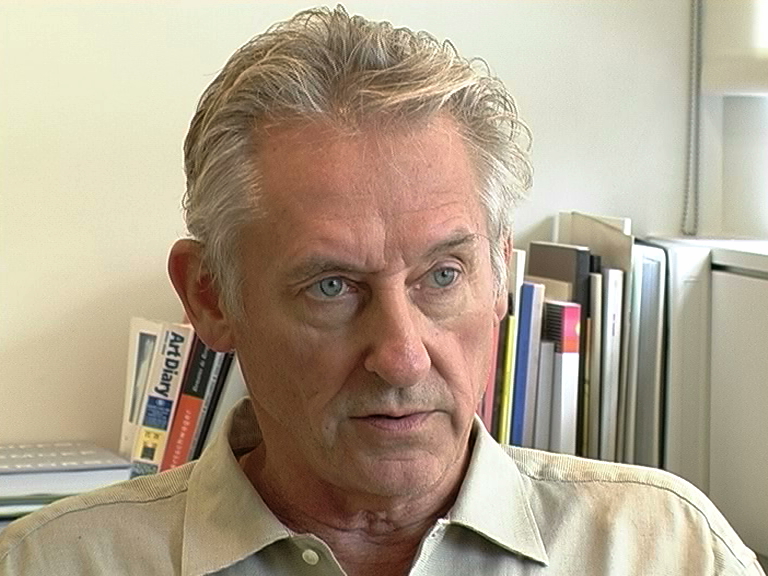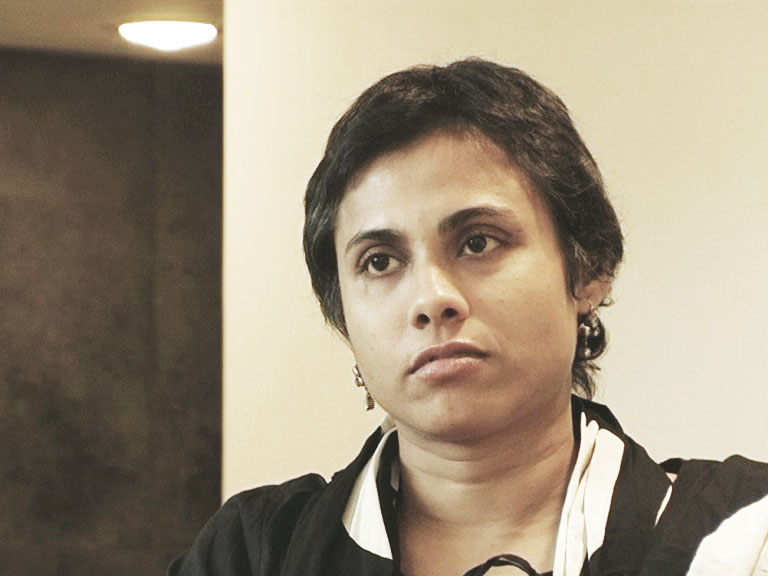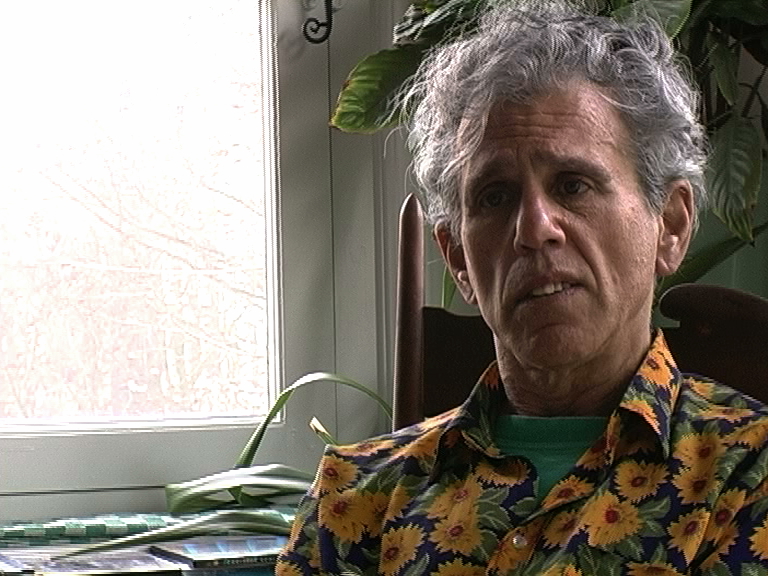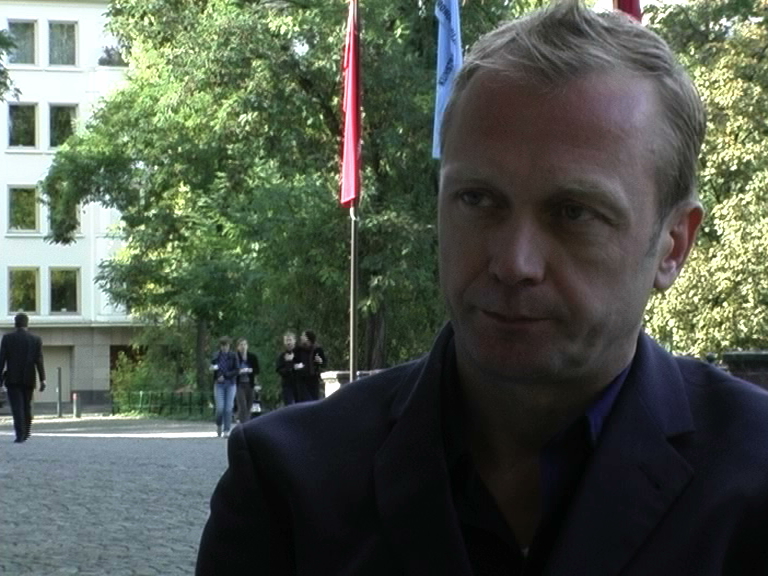Victor Burgin
Goldsmiths College, London, Nov. 27. 2005
read the interview
S.R.: What do you consider the strongest influence on your practice?
VB: It’s difficult to think of a single influence, and even if one were to give a single instance, one would have to periodize it. There are clearly things that influence one differently at different moments in history. Again, influence, but I would think rather interest; for the past five or more years I’ve been particularly interested in the Baroque period, especially musical theatre, especially in France. So most of the reading that I’ve been doing over the past five years or so has been in the area of French Baroque music and musical theatre. Well, this is not something that directly enters the work; only occasionally in the videos you have a little bit of Baroque music on the soundtrack, and earlier this year in France, I had a commission where I actually included the performance of a piece, the very first performance of a piece that has been languishing as a manuscript in the Bibliothèque Nationale for some 300 years, and we had the first performance of that piece as part of a video. But it’s not something that comes into the work directly; but it’s rather an ethos, it’s rather a structure, a way of approaching representation. I think I’d probably say that these structures – if you like, in the most abstract sense – are with one, as part of one’s – in lack of a better term at this point – as part of one’s personality or part of one’s psychical make-up. Perhaps what happens is that at different moments in life, we find these structures in external objects, and these external objects can change over time. As I say, most recently in Baroque musical theatre.
S.R.: Would you say that this Baroque theatre, this time, is something also like the main interest in the history of art – or would you differentiate between baroque theatre and art in general, like painting, sculpture, is it for you the same range?
V.B.: I’m wary of global terms like “art“. Again, one would have to label this term a little, one has to periodize, because what art means varies throughout history. You know, the closest that we come to the modern term “art” in classical antiquity in the West is a word which simply means „that which can be taught“. In its origins then, music, if we stay with that example, was not an art, because it was performed by priests, and it was believed to come from the Gods. So it was a matter of inspiration and divine intervention on Earth; it could not be taught and therefore was not an art. Well, with the Pythagorean theories of harmonics this changes. Similarly with poetry; poetry was not originally in antiquity an art, because that again was a matter of divine inspiration. Then we get Aristotle’s “Poetics“ and things begin to change. But it’s interesting to think of art as that which can be taught, given the post-romantic fog that we still languish in in the art world where the notion of divine inspiration is still there; but it’s actually contradictory to the original sense of art. There are other people who have said, of course in different contexts, that science is that which can be taught, and we are speaking in the context of a teaching institution. For me, I think it’s a matter of contingent definitions in different historical periods; if we were to look at it now, then the definition of what art is would involve overlapping discursive formations. You would have sociology, for example the sociology of the art institutions; you would certainly have the economy which plays a greater role in Western art today, arguably, than it did, let’s say, fifty years ago – let’s not go back to the baroque as it was paramount in that period, obviously. But the market – again, you would have to have a political discourse describing the mutation of contemporary art in the context of neo-liberalism and global capitalism, the incursion of market values into every aspect of culture. which again we suffer in the university, especially in England where the incursion of market values into the universities changed the nature of education and I think it certainly changed the nature of art since the late 60s, early 70s, which I believe is the period that you are supposed to be relating to in this interview.
S.R.: So you took us more on this course to the 1970s, maybe let’s come back to the first question where you said that it’s very necessary to periodize this question of the influence. When I want to go through the different developments of your work very briefly then I would say in the beginning of the 70s there is lot of self-reflection in the language. But these are installations on the wall. Then I see a lot of work, theoretical and practical work, with photography, in the end of the 70s and in the 80s; and in the 90s, if it’s right, you changed more and more to video, video installation; a lot of sound, music, performance. How do you see this development?
V.R.: From my perspective it’s completely consistent. The movement between language in the common, accepted sense of words, writing, speech, and the image; that movement between those two registers of representation has been constant from the early work to the late work, and video is simply a technological development out of the photographic work that I was doing previously where there was text with the photographs. And what’s at the centre of all that is, I think, quite simply a kind of phenomenological interest which, I would think, probably we can again, to periodize it, to speak autobiographically – probably began when I was at Yale, in the School of Art and Architecture at Yale University in the mid-60s, taking classes in philosophy which were centered mainly on readings in phenomenology, and at the same time readings in Artforum, for example much discussed at the time amongst the students. Robert Morris‘ notesome sclupture which had very much a phenomenological framework, and Ed Michaelson’s work; and being very interested in that period in Minimalism which again had a very strong phenomenological component to it.
So I don’t think I have ever lost that phenomenological kind of orientation, that concern with attempting to represent the way one actually perceives the world, the active perception itself which inevitably leads one to look at – in more recent terms we would say – the “interface“ between an interior subject of mind and an external object of reality. Of course that’s greatly to oversimplify the situation because “mind” is precisely just what happens at the interface between which… obviously an interest I share in common with a lot of people, not simply artists, but also philosophers, writers of all kinds. If one speaks about it in general I think that’s one of the things that art has consistently paid attention to or can be read in terms of, throughout its history, and which it shares in common, as I say, with other forms of literary art and with philosophy. So, when I look at the world, I also have memories and I have words coming into my head, and the visual and the verbal can’t actually be separated. So I accept that and I try to work with the visual and the verbal as simultaneously present registers of perception – which is not to say that all the work is about is the act of perception, but that’s where it begins.
S.R.: So it’s something like a circuit starting with the language, coming to photography, the question of the image and increasing it to the space and the interrelation between sound and the image and language? That was my understanding.
V.R.: Although I wouldn’t say I started with language. It’s rather a matter of trying to hold the verbal and the visual in balance, trying to represent the constant simultaneity: the verbal and the visual, the visual and the verbal; a word gives rise to a mental image, and looking at something visual in the outside world, that may give rise to a word; so that’s like a continual movement between those two registers; the movement of photography itself very largely had less to do with phenomenology and more with politics because in common with a number of other people, in the context of the late 60s which – to state the obvious – was a period of great political ferment; one thinks of the anti-Vietnam protest,one thinks of the resurgence of the women’s movement, of the civil rights movement. A lot of political ferment, it would have been very difficult not to have that dimension of the political present in one’s mind, working in that period. You could turn away from it and shut yourself in your studio and ignore it. As I say, in common with a number of others I wanted to open the studio door, I wanted to inscribe that aspect of experience in the work. They became different ways of trying to do that, because there’s always the danger – and no doubt I fell into it myself – of simply moving into a kind of propagandistic mode, which is fine if you are working for an organization, and I did all bits of work for trade unions and I was very happy to do that but in fact the circumstances here were such that there wasn’t very much room for that; British trade unions were not on the whole very alert to issues of the image. I think that only entered British left politics with Thatcher’s success, greatly assisted by Saatchi, and I think that’s when the Labour Party in England woke up to the fact that the way they appeared, the image, that the phantasmatic, the imaginary fantasy actually is a moving force in politics. Whereas it was the conventional, certainly on the Left, to think of politics purely in terms of rationalistic schemes, of contractual negotiation, of rational protest, the revindication of wrongs and so on in which the phantasmatic, the image, never entered. So that the negotiation between the image, the political, and what’s proper to this sphere of “art“ – which again has to remain a kind of fuzzy concept – that was part of the work. The move to photography was a move away from painting – I have a first class diploma in painting from the Royal College of Art which means that I’m legally entitled to practise painting anywhere in the United Kingdom and I gave up that – for two reasons: one was certainly from my perspective in the late 60s there was nothing left to do in painting, technically there was nothing left to accomplish; the minute you picked up a paintbrush it seemed everything was over; just that act, just that gesture of picking up the brush brought with it so much that was so shackled to certain historical structures that politically I was not entirely happy with, so shackled to certain political structures, that one couldn’t continue. So that’s kind of politics of giving up painting also, but to turn to photography was to turn to a medium that was very much in the public sphere, that didn’t intimidate anyone. So that was a kind of populist gesture towards photography. But also at the same time these kinds of decisions and moves in one’s life, in the life of everyone, they’re never that simple, even if you may try to represent it to yourself simply later on, or tell it simply as a good story; but actually I think all sorts of decisions are heavily over-determined with a lot of factors working at the same time; one is pulled towards something or pushed away from something at the same time. I was pushed away from painting for mainly political reasons but also for technical, historical reasons to do with the history of art and the perceptions that there was nothing left to do, a perception, which I still hold. And there was a move towards photography for populist, political, “left” kind of reasons, but not only for that. It’s actually quite a fascinating medium, and I actually started to write about it because of the interest of the relation to the image, to the photographic image, the whole issue of the imaginary; that also was kind of intellectual interest, an aesthetic fascination but also a political reason for the move to photography and video.
S.R.: …
V.R.: had a cold recently, throat …
rausschneiden, weiter bei 00:19:56:30
S.R.: I wanted to come back, to focus a little bit on this question: You explained the difference between the political reason for the shift between painting and photography, but maybe you can say something about how, in your perspective, photography changed in the political question the use of photography since the middle, the end of the 70s to now. I think maybe that could be interesting.
V.R.: Yes. In art or?
S.R.: Yes, in your perspective, from the perspective you already explained that is important for you, it was important to work in relation between photography and the image and I think their is a
specific concern of how the image is working in the art field, and how the image is working in a broader field like advertising or public space.
V.R.: Sure, yes. Your task is specific questions that we come with in.
S.R.: Yes, I think it could be interesting to have, in your perspective, how you developed that in the former answer, how in your perspective the function of photography changed; in relation to that, how you see the image changed in the last 20, 25 years.
V.R.: In the beginning, as I said – I’m leaving aside, for example „photopath“, or „performative-narrative“, early works of mine, which were squarely within that area of phenomenological interest, at least „photopath“ certainly was. So leave aside those uses of photography, If we come back more to the use of photography as it began in the early 70s in my work – that was more clearly political and that was largely motivated by those considerations that I’ve already touched on – the idea of working with an image that was out there in the public domain, a kind of practice that was out there in the public domain in a way which painting was not and could not be; the photograph is part of the environment; it’s difficult to go through the day without seeing one in one form or another. And the photograph contributes to the perpetuation, consolidation, re-affirmation of common beliefs and values, it contributes to what one time we would call “ideology”. That was the reason to move to photography and away from a practice, painting, that was confined to the art gallery, to its values which is largely economic, you know the market and so on. At that time there were basically two forms of photographic practice that were very obviously political: one was advertising, clearly, and the other was documentary photography; I worked with both those forms. I produced posters in which I reproduced a rhetoric of advertising but in a form of view – the Situationists would have said “détournement” – turning those forms as they were against themselves and making a formal study of rhetoric, analyzing advertisement from a rhethorical perspective; in a line of work begun by Roland Barthes and Durand, there is all that in France in the 1960s, and I carried that in my teaching. About that same time I moved out of an art school into a film and photography school, precisely in order to be able to base my teaching, because it seemed to me that teaching again is a form of political practice, and certainly a more effective form of political practice than any form of art practice ever could be. I also spoke about documentary photography: I actually moved into a school, the Polytechnical Centre London which is a kind of self-defining “political” school – so the film and photographic practices there were very, heavily self-defining political, but in a traditional documentary mode; when I went there with a lot of French structuralist ideas; set about persuading people that the documentary mode was not a window on the world, that the truth was not reflected along with the light from the object; that there were complex and largely unperceived filters that intervene between the actual perception of the image and one’s ideas. I started to break down this idea of a divide between advertising practices on the one hand and documentary practices on the other; the two were considered to be totally separate; set about to show how in fact they were not so different. So my own practices in the field of art were drawing upon documentary conventions, drawing about advertising conventions; and then, deliberately, and it sounds provocatively, mixing the two; so in those works from the early, mid-70s I would shoot pictures in a documentary style, black and white, taken in the street very often, or in a place of work, and then overlay text on them in the manner of advertising, often writing as if it were an advert or sometimes taking something directly from advertising and putting it into it. So it was like a kind of mixing of genres and practices that I was interested in. And the other reason for doing that was to again to make a hole in the gallery wall onto the outside world. That was the early 70s – things have changed totally; you don’t need to make a hole in the gallery wall; the walls, in a sense, have fallen down completely; and it’s not at all uncommon now for people who at one time would have been defined purely as advertising photographers… editorial photographers, who shoot for glossy magazines … to have those people showing their work in galleries; … or fashion designers take up a camera and exhibit in art galleries…. What’s happened to the art world in the intervening 30, 35 years … in a sense I’m responsible for that; a victim of my own success; what at one time would have been the specificity of art, the area of differentiation from the mainstream of the market society and the market economy … the sense of there being a difference has completely been eroded, it seems to me. The issues cannot be what they were in the 70s; in terms of technology, things have moved along enormously, too… What’s the status of documentary photography as classically defined as it would have been considered in the 1970s; … Barthes said: history is what happened before you were born. Speaking of history… What’s the status of a black-and-white film image and photograph in a world in which kids take pictures on their mobile phone … internet; early days of the Iraq mess … Abu Ghraib … the soldiers also take pictures of routine atrocities and broadcast them; a great many of what passes for documentary photography, photographs in the newspapers these days are grabbed from the air, taken from video images … other forms of digital photography… Technologically things have completely changed; economically, ideologically also … which is why I cannot do the work now that I did then. The idea of being an artist and of “doing your thing” is totally … unrealistic … relation to the external world, because the world has changed so much.
S.R.: .Now we have reached already the second issue of questions – because I wanted to ask you how you see the difference in the documentary photography to the contemporary … digital influence …
V.B.: … there is more to be said there, always.
S.R.: … practical approach and theoretical approach … theory of documentary photography has to be differentiated vis-à-vis your old approach, to digital influences; or is it possible to continue the old documentary idea.
V.B.: The whole issue of documentary has to be rethought … if one were writing about it now, one would have to rethink it. It comes down basically to something rather abstract, it comes down to the question of indexicality … of the photograph .. the image as witness; I think that a lot has been made of the fact, in the wake of Baudrillard; the notion “simulacrum” … with digital photography there’s no negative, so there’s no point of origin to which you can refer … a piece of film originally exposed to the light of that event; you can no longer argue that it’s been changed, that it’s been falsified; in digital photography there is no negative… you cannot move back to that original document … That’s rather missing the point …. I don’t think that there’s been a substantial amount difference established between the original film-based documentary and digital documentary; if we take the example of the pictures taken by American soldiers in prisons in Iraq … of atrocities committed upon prisoners … someone said these are digital photographs therefore we cannot trust them, you can have the same argument of film. The point is that the photograph on its own never stands on its own as a witness, it always has to be supported by testimony; court of law, somebody says, I was there, this did happen, I saw it. Indexicality is an issue that can’t be separated from questions of jurisprudence, you can’t determine issues of indexicality in the abstract, through either a philosophical or a technological argument the issue of indexicality, where it bites, makes a difference on the world – is a question of witness, testimony … it cannot be seperated from the word and from the body … Some of the changes that people have got excited and written at great length about are really not that important in the end.
S.R: I’m really happy that you said that, because I very often have the feeling in the discussions on digital photography that… also in earlier writings on indexicality, that many of the authors just take indexicality as something like a given thing in the worst of photography, and I’m exactly of your opinion, that I always try to think or to say that you need something like a witness, it’s not there // that’s right//; the difference between the old paradigm of documentary photography or the new paradigm of digital documents is not so big, but you have technical differences and you have these different functions in society and that’s the reason where I want to come to the question of representation. … In Germany we have for … four weeks a new advertisement for a Cybershot camera from Sony, they say: “Don’t think, shoot” //yes// one thing is that they took it from Lomo photographs, it’s exactly the slogan of Lomo – these Russian, very cheap cameras, but that’s not so interesting to me, I want to take this sentence, „Don’t think, shoot,“ I want to take this in relation to the increasing number of so-called “documents” from crises fields on Earth, like you said already the whole mess of Iraq and it’s bringing something like a very war-time idea into the public space, into the public sphere, when you read in the street „Don’t think, shoot“ and you see the advertisement of a camera. For me it’s a really strange change of behaviour in advertising in the public sphere. …This mixing of the capitalist use of images and verbal information in the public field is combined with this advice – which says, on one level it says „Don’t think, shoot“, very aggressive.
V.B.: Yes. I could both agree and disagree with you. I disagree that there’s any great change of behaviour in advertising; advertising has always been aggressive, advertising in its nature is aggressive. “Don’t think, shoot” – again, advertising offers instant gratification; and I think that that offers instant gratification, I mean basically what they are telling you is that, in a sense, there’s no instrument between you and the image that you’re going to make; …it’s “point and shoot”, I mean I think the point that the ad is making. You don’t have to think about the controls, you don’t have to think about the settings; that’s the kind of “sell” they were using even before digital cameras there were increasing numbers of transistorized circuits in cameras that would automatically fix the exposure and so on. To that extent there’s been a great change – I agree with you that the message embedded in it, which has nothing to do with the easy use of technology, is chilling; the aggressivity can easily be mapped onto the aggressivity of global capitalism in general as represented by the current American administration – who don’t think very much and shoot a lot. So “Don’t think, shoot” possibly could be inscribed over George Bush’s office, absolutely. I agree there that they have that kind of message in the environment continually reiterated, reinforced has to have certain implications. I used to say to my students a long time ago, it was things differently, I used to say to them… what happened was that I was teaching theory to film and photography students, it’s a three-year course, and in the end of the second year find this phenomenon of students individually coming to see me, talking around the issue for a while, finally coming out of what they wanted to say, saying: „Don’t get me wrong, it’s not that I’m not interested in the theory course, I find it very interesting but I’m starting to find that I can’t take a picture any more; so every time I lift the camera I think ‘what are the implications of this?’, you know politically, whatever.“ My advice is always the same: I would say: „shoot first, ask questions later; take the picture, allow the unconscious to speak and then afterwards you don’t have to show it you may not even decide to conserve it or only in a certain context or accompanied by a certain text… that process comes later. ‘Shoot first, ask questions later’. But again that was a different time, a different moment. As no sentence stands by its own in one context, it has a way of drifting into other contexts. “Don’t think, shoot” today is quite horrific. But I mean, again, this raises, you mentioned that early, the collection I had on „thinking photography“. This raises a whole issue of the image and the thought; and of course “thinking photography” was deliberately ambivalent, ambiguous: Is it the photography that is thinking, or is it thinking about photography, or is it the two things at the same time? Art for me is a way of thinking; using photographs rather then perhaps more traditional media in art… painting but the decision to use photographs in the first place in the context of art was the result of thinking about art. And becoming unhappy with the development of conceptual art, with this hermetic tendency within conceptual art, to have art as a way of thinking about art; this totally circular, totally self-referential attitude is one that I became unhappy with. The move to photography was one way of necessarily engaging with the world outside of the institutions of art so thinking about art necessarily involved thinking about other things at the same time. That became very important. I just wanted to say that… to move into that area of photography is not actually to move out of the area of art but is rather to contribute a redefinition of the area of art; and in one of my subsequent books, “the end of art theory” again was a play on the sense of that; the end of art theory: does this mean that art theory has come to an end or does this mean the end, the goal, “le but” of art theory: It meant the two things at the same time for me it meant that a certain way of theorizing art that was concerned mainly with an idea of art itself and nothing else, had to come to an end, had, in fact, come to an end that to continue to walk and talk like that was to have entered the realm of the living dead; because it really has no purchase on the contemporary world. So that was the argument. Then the end of art theory, the goal of art theory, but nevertheless one goes on, one continues to speak simply because of the way of history pushing you and if you leave the art institution and speak, if you’re outside of the art institution, and you speak, then the speech in a sense is meaningless; because it’s void for a lack of reference, there’s no context giving a meaning. So again it’s a matter of trying to negotiate that relationship not simply philosophically and philosophically, between the world and the image but between this institution and the other institutions in which it’s embedded and which increasingly invaded; so art is a way of thinking but what kind of practices are the best, what will help you to think, and what should one be thinking about? …Rather, maybe to move back to one of the origins of conceptualism, in a rejection of anything that defined art in terms of market commodities in favor of – what has always been part of the history of art – in market society nothing escapes the market economy – but not to have art reduced to that, not to have art defined in a certain way determined of that. But find a way of thinking that could engage outside of the economy and the protocols of the society of the art world.
S.R.:
V.B.: You can ask the question, but it’s one that, in a sense, can’t be answered, otherwise there would be no practice. It’s very difficult to put in words that would make any sense I’m trying most simply what I’m doing what I’m working: I’m trying to formulate something, and I’m trying to discover what it is I’m thinking about, because when I start I don’t know. There’s also the question of affect, there’s also the question of the emotional relation. And again, the origin of that is largely enigmatic and mysterious. What remains of interest to me in the field of what we call generally “art practice”, what keeps me “at it” with that work is the undecidability of it; that even though writing – and I do write obviously – has an element of that undecidability and I imagine that for creative writers, and I as most of my writing has been creatively, I hope, nevertheless in the area of theory, mainly in the context of the University. Most of my writing today has been an intervention within the Academy, so a lot of it has been aimed at mainly graduate students from thirteen years up to three years ago purely graduate theory on the University of California. So the writer’s intervention and the kind of the poses many questions on identity, identity politics very much in forefront of debates in the US academy, while I was there; the writing was aimed as in intervention in those debates and not simply use theoretical tools but introduce theoretical tools to students, so there would be quite detailed explanations of, for example, psychoanalytical concept. Even though writing, when you begin to write you don’t quite know what it is you are going to write and you don’t know quite how you’re going to formulate things, by the time you get to the end it’s always something of a surprise; nevertheless there is more of an element of being able to predict what the result is going to be; there is certainly a goal, the sense of a goal – to come back to the idea of a goal here – as my goal there was to intervene in a set of debates. Largely to say: the identity that you think is given to you by – I’m not going to say „class position“, that’s the last thing say talk about in the States – but certainly by an ethnic position, a racial position, it’s not as simply as that and I try to bring in some of the complexity of issues of identity into identity politics, a complexity derived mainly from readings through psychoanalytic theory. I can’t say in a same way or even in a comparable way, when I’m working, as I’m working know, thinking about a new work, I can’t say that I have a goal in that sense; I can’t say I’m going to make this intervention. I would think that maybe in the late 60s, early 70s, one could have that sense because one was still working in the line of modernism, in the line of a Greenbergian teleology where you had a sense of questions raised and solved by one generation that would raise further questions to be solved by the next. In fact, before Greenberg, it was Vasari who introduced that scheme; for example with Vasari it was cyclical and with Greenberg it was the teleology into the perfect future where the painting would be nothing else but a painting. So that notion of having a goal, of making an intervention in an art historical progress, a teleology that was possible within in the context of modernist aesthetics; minimalism was a contribution to modernism in that sense, and conceptualism, in its turn, also was very much caught up in these modernist aesthetics and I feel that the hermetic tendency in conceptualism never escaped the gravitational pull of Greenberg – so art is enough for them, you know they can only think about art and it’s about art. But although in the early days one could have a sense of a goal and a sense of an intervention in an ongoing history, it’s more difficult now. What I would retain from Greenbergian aesthetics is the notion of specificity. So Greenberg would say for example about any art, what the “best” art – tautological definitions – it concentrates on what it does, what other arts don’t do. So you don’t perform dance i a painting and you don’t do musical painting. I think the notion of specificity can still be useful in terms of defining an art practice: What is it that I’m doing or may do as an “artist”? – which is not a personality trait, it’s an occupation or a vacation whatever or a fantasy. But what can I do in this practice that I don’t see being done in other practices? I think that’s one way of thinking about a reason, but not necessarily thinking about a goal. Which is to take a lot of time to evade your question – to deal with these questions. I think that are the questions of content, the questions that one has to circle around, perhaps quite simply the unanswerable questions.
S.R.: …You were already talking about the historical references to the modernism of Greenberg and the difference between Minimal art and Conceptualism. I want to turn a little bit more to conceptualism and the question if there is something like a field of conceptual practices, or a field of Conceptualisms. …Then, we can define or we have to define something like paradigms if we want to have something like a definition; this is the reason why I ask: Do you think that the conceptual paradigms are still in function? Or, to put the focus at the question a little bit differently: Can new conceptual approaches be realized in contemporary art and society?
V.B.: The origins of what we call conceptualism, historically, are in the late 60s, developments into the early 70s, quite a relatively short historical period. Those I would see now with the benefit of hindsight, but, by the mid-70s I was totally convinced that this was history, but earlier than that the origins of what we call conceptualism were very much modernist – so to put a bit crudely, one could say that minimal sculpture moved away from what they considered “illusionism” in painting. So Greenberg was hoist by his own petard, to use that odd expression which, I think, is a naval expression, originally – he had a totally different approach to the object, but it was in the interest of a kind of Greenbergian kind of desire for movement and for innovation – and for purity, “essence”, a kind of essentialism. And that started us down the path. To speak anecdotally, when I was at Yale in the mid-60s, Donald Judd was visiting and Robert Morris came up from New York to teach there; Robert Morris said in one of his articles that he wanted his work to be no more or less important than any of the other terms in the room. To translate that, I would say that his great cube in the middle of the gallery was to be of no more interest than the molding along the wall or in the ceiling or the door frame or any of those other objects. I actually asked him: Then why have your object? Why not just direct your attention towards the room; he actually denied having written that, because he wasn’t able to answer the question. When I made this early work, “Room”, that was exhibited at the Camden Art Center in 1970, in a sense it was an answer to that question; there was no object in these minimal sentences pasted to the wall, but all of which directed your attention to your own active perception; the only object became a kind of mental construct. Donald Judd, when he came out to Yale, I remember him once saying – and the ‘light went on’, you know: ‘A form that was neither geometrical nor organic would be a great discovery; it occurred to me that the only form that was neither nor was an immaterial form, so: a mental form. That for me – and I’m speaking anecdotally – wasn’t the same for everyone else; but it was those kinds of phenomenological concerns for me were the origin of my own version of so-called conceptualism, allied to, welded with a kind of late 60s radical rejection of the market society, the society of the spectacle, the commodity society. That was the beginning for me, absolutely. Today it’s a completely debased currency; anything, which isn’t a painting, is a piece of conceptual art, and most paintings are claimed as being by conceptual artists. It’s become totally redundant as a term, it’s completely useless. It’s a kind of a flag of convenience, or a badge of allegiance, or a brand name, but it’s meaningless. It’s completely meaningless. I think there the response would be, in the words of T.S. Eliot: “O do not ask what is it, let us go and make our visit” – you know, the devil is in the details. Don’t say “Is it conceptualism or not?” Let’s see what they are actually doing, Wittgenstein: “Don’t ask for the meaning of a word, look for the use!” What are these different artists – regardless of what they claim – what are they actually doing? What’s their relation to the market, what’s their relation to history? Then you can have the means of specifying particular practices and then grouping – in a kind of taxonomy – various practices together which is probably more valuable than simply saying “This is conceptual”, “This is not conceptual.” To get back to the idea of art as a way of thinking for me that’s what I value in it but also that it’s a site of the affect; in a sense it’s where thinking and emotion come together in a way that’s institutionally acceptable and framed – I’m really treading on debatable ground here, because I think probably philosophers would say that if you read a philosophical text and be moved, there would be something wrong with the text, because it’s supposed to be within the realm of pure reason – but I think that the affect enters into all of our relations to philosophy.
V.B.: Maybe it’s just to move on debatable ground, but I think it’s problematic to say that „most people“ (shows quotation marks with his fingers) would consider that the practice of philosophy and the writing, the philosophical text, is a rational affair – by definition. Therefore, if I were to say, „I read this philosophical text, I was deeply moved“ I think I might give rise to some doubt as to the nature of that text. It clearly was a failure of the text if I felt moved in reading it. But I think that that is a product again of a kind of rationalist ideology. Certainly some texts leave me cold and others move me. To say “ I’m moved “ is not to say “I’m deeply moved”, certainly not moved to tears or to tearing my hair, to beating my breast – but it’s an affective dimension to reading the work of some “intellectuals” and not always. The result of the quality of the writing and the result of style, there is a poetic dimension which carries that affect, it becomes the semiotic chora in Kristeva’s definition. There is a poetic dimension to a text. But I am speaking quite simply structurally of the inescapably poetic dimension of language that they enter into relations that are formal, that one practice of writing differs greatly from another. But there is this inescapable and often unadmitted dimension of poetry in the most rationalist writing. So, when I said „art is a way of thinking for me”, that is what I value about a practise it’s not to say and it’s also a frame for the deployment of affect – this is not to distinguish it on that ground from other practices, other practices of thought, which I think it has been one of the ideological basics of at least popular notions of art: that’s the side of emotion, that’s philosophy, that’s the side of reason, but, again: these are ideological distinctions. I can’t quite remember why we started out on that one, but perhaps we could come back on the position of art as way of thinking.
S.R.: I asked for your paradigms.
V.B.: Of conceptualism? If I could intervene there, I think we are all critics when we look on a work of art so I don’t practise criticism as such in the sense that I don’t write about art. I like to say that on tape because I’m not being frequently asked to do so, I don’t to write about the work of other artists but nevertheless when we look on art we are all in a role of art critics and I find very often … to be honest … after a long time in the art world, you find it harder to find works that are really engaging, really interesting, but the ones which do engage me and the ones which interest me are often the ones where I believe I can see a process of thinking that’s persuasive and coherent, and the ones of which I become disinterested very quickly are precisely the ones where the thinking seems to be so sloppy. Everything is conceptual art today – but so often the conceptual aspect, in a strictly literal sense not I’m speaking now of art history, the thinking, the quality of the thought seems to be very poor. I haven’t seen art criticism who speaks about that but then I have to admit that I don’t read art critism.
S.R.: Maybe I go a little bit further with another question. I wanted to ask you: How do you see the return of conceptual surfaces and the contemporary fashion of “retro” styles? Maybe that’s another perspective on the same issue.
V.B.: What do you mean by „conceptual surfaces“? You mean the appearances of conceptual //exactly// art, the style?
S.R.: Exactly what you described that you see a lot of work some interesting, some less but the thinking, the is very pure and sometimes I think it’s just the surface … sometimes I have the feeling that the students or young artists just flip through catalogues of the end of the sixties, beginning of the seventies and then they have an idea and they make a painting on a wall, really big, and that’s a painting, nice colours. //That’s right// That could be one example. Or maybe, I don’t say this for the film, I interviewed (??), do you know him? From Los Angeles. He often explained that anything of works of Robert Smithson, of Donald Judd, something like that is just like a designer, he’s taking parts of the installations, for example Smithson, the idea of side and non-side is not just you have an open space with some earth or some ground and you put some rocks inside a gallery and then you have an art side, for me it’s much more like an epistemological model //yes// and he is just playing with the elements //yes// and this I call it, forgive me, but I just call it „conceptual surfaces“ //yes// and so I wanted to emphasize what you said in your last answer. How do you see this return of conceptual surfaces? Or you can also come from the other question: contemporary fashion of retro-styles, its only a style, it’s not the epistemological move.
S.R.: So I think I have only one more question for this set. … What is your ideal and typical daily work as an artist?
V.B.: Ideal and typical, those are totally different. (laughs) Those require totally separate different answers.
S.R.: Maybe a little bit in respect to the supposed title of the film „Conceptual Paradise“//“Conceptual Paradise“?//Yes.//Ah!//
V.B.: Yes. Well, this is supposed to be the amusing answer that gives the audience some kind of compensation for the seriousness of what came before: I think my paradise would be like every one else’s paradise I think one would beginning by removing George Bush and Tony Blair from office, that’s for sure (smiles), and Charles Saatchi would have never happened to Britain (smiles) or (?). That would be the beginnings of establishing heaven on Earth, you begin by clearing out. But “typical”? It’s quite simply: each work is researched and so for each work, as I’m move into each work, it’s preceded by a lot of research so that a typical day is involved in doing that research. So the research then becomes the foundation for the work, but very little of it goes in the work itself. But it provides the ground, it provides a firm foundation for the work to be constructed on But then the work of construction – the work of research is easy, it can be quite gratifying, you know I can find the resources, I can do the readings or I can visit places or I can take photographic records, I can start to construct knowledge of what I’m working on. I mean, to be less abstract: right at this moment I’m working on a piece for a show in New York next year where the research consists in informing myself about the Chase-Schindler’s house, so-called Kings Road House in Los Angeles, build by Rudolph Schindler between 1920 and 1921; and at the same time researching into and around the early an early to mid-18th century French erotic novella, in which architecture figures prominently. You know, two different times of research: I get to L.A. to photograph the house and in libraries in Paris researching the background of the novella. That’s kind of easy to do but then I think the difficult thing begins with the construction on that foundation, because one begins with the intuition here – two items which have nothing to do with each other in a certain way and yet seem to have something to do with each other, and the process of working is a process of my finding out what they have in common – for me – or at least making a construct in which they have something in common in the work even though they have nothing in common in reality. …That’s, if you like, a typical day, if I leave out the usual things like having breakfast and, you know.
S.R.: I suggest that we just keep sitting and maybe we continue talking on this work and as we are finished with this situation maybe you can take the camera from…
V.B.: I find it very difficult to work externely so I tend to work at home //I see// This was given to me by the school when I came here and (…) I came from the USA with a lot of stuff and I had a large house in America so a lot of stuff that I couldn’t fit into my flat in London I had to put here, where I keep throwing stuff out and on one time you couldn’t actually walk into here ‚cause there were so many boxes gradually throwing everything away and that’s what this is really and I, it’s not actually where I work but that’s o.k.
S.R.: You were talking about the research on the Schindler house and this French erotic novella. Do you already know where this work will be exhibited, and do you have an idea of it because maybe a video installation, or a photographic installation?
V.B.: …It will be shown first of all at least at the Christine Burgin Gallery in New York and I’ll be talking about the work and about issues coming out of the research at the Cooper Union Architecture School in New York, just before the show opens. A number of my works of the past few years have involved architectural sites; all of my works have involved a sense of place, so all of these works, photographic works from the 80s for example, or the seventies shots in the cities in Lyon, Grenoble, Berlin and so on. (…) Last year I made a work on the: Dominique Perrault, a Baroque creapian (?) again, the Dominique Perrault Bibliothèque Nationale in Paris, I used that sight and then the Mies van der Rohe house, the Barcelona pavilion, in Barcelona; so the Schindler house, belongs to kind of recent line of works using architecture so it has an architectural reference in place. The erotic novella was actually written in order to promote an architect’s services. So the idea was that a rich clientele would read the book, and in reading the book they would be exposed to architectural ideas, of course in those days, inseparable of what today we would call issues of interior decoration, and it’s essentially the story of a woman seduced by architecture //That sounds interesting// Yes (laughs). It’s the set-up of “the irresistable force meets the immovable object” – the irresistable force is the Marquis de Trémicourt who is rich, handsome, brilliant, witty, has good taste and the immovable object is the virtuous Melite, this brilliant totally virtuos young woman and Trémicourt whiches to posses her. She is quite happy to talk about that but to tell him that it will never happen so he challenges her to visit his petite maison. Now, in that period, late Baroque, before the Revolution of course, a typical aristocrat of this type would have his château in the country where he would hunt and have his lands that would produce income; he would have his hôtel in Paris where he would have his kind of official seat in Paris, living his serious business and his retinue; he would have his maison de plaisance on the outskirts of Paris, which of course in those days is very small, on the edge so that you can see the country on one side and the city on the other and that’s where all the water painted will take place that will be somewhere where he will go not in hunting but in fruit gathering or something like that which gave him a form of sociability and would hold parties and it would be for pleasure; he will also have his petite maison de plaisance which became abbreviated as petite maison, little house, and that’s where he would escape all the people, because aristocrats in that period were never alone, there’s always somebody around. So he would go to his petite maison and that’s where he would meet for a sensitive political discussion, or economic discussion, but more often for his erotic encounters. (laughs) And so these people spend a lot of money for these petites maisons to make them absolutely “paradise”, behind high hedges, féage, folie it became, so from that house became what was la petite maison so … this is a place of folie and madness but awesome. So he says to, Trénicourt says to Mélite if you visit my petite maison then you would surely ge given and she says: „I accept the challenge“. So she visits him, and each chapter is a visit to a different room and he describes the furnishings… So for historians has become a really valuable source of information about the interior decoration of that period. And in one room he describes and shows her the water closet which he says is the very latest design so the excrement could be flushed away and – this is all in the book (laughs) you know why it’s seducing… And then there’s the garden of course, end of course, needless to say, by the end… she has held out till the last, but the last room is too much and her senses have been so overcome by her progress through this house that by the last room – and it’s a very beautiful the moment when she moves into the very last room he steps (makes a step with his feet) on the end of her dress so she has to turn around so when she turns to the room she’s already in it and she get’s the full impact and she just collapses onto the nearest couches and that’s the end of the story (smiles).
S.R.: What is the title?
V.B.: La petite maison
S.R.: Ah, Bastide.
V.B.: And it’s translated into English as The little house.
S.R.: By the way. You want to sign it?
V.B.: Sure.
S.R.: Thanks a lot.
S.R.: In my feeling everything was very fine. I have two little questions I want to ask you and for these
V.B.:
S.R.: Would it be totally weird to ask you about the function of the intellectual in the contemporary world?
V.B.: It wouldn’t be weird, it’s a perfectly reasonable question. I think I would risk appearing self-aggrandizing if I attempted to answer it directly because (…) it presupposes first of all to define what is intellectual, and then it presupposes that I’m able to speak more or less on behalf of all matters of that class. I’d accept being called an intellectual in the strictly Foucaultian acceptation of the term … it is Foucault who makes a distinction between the “universal intellectuals” and what he call ”organic intellectuals”. The universal intellectuals are the best representatives in recent history, the best example would be Sartre who spoke on behalf of humankind; the organic intellectual, an example for an organic intellectual would be a Trade Union organizer, someone who is within a defined area of practice, reflects on that practice and acts in that area on the basis of the reflection. So, within the art world, yes, I am an intellectual, as are many other artists in that I reflect the activity of art. In a sense most artists today being through institutions like this, had been to universities and this is what they’re expected to do, so, in a sense, they’re all intellectuals, although nevertheless there is a lot of anti-intellectualism within the art world; it’s one of these curious paradoxes. If you go back, something I think of by association, a book that I am rather fond of, Renssellaer Lee’s „Ut pictura poesis“, a little classic in art history. And of course of that he talks about the 17th century doctrine of the “learned painter”, and of course it was on the basis of that argument that the first art schools were formed. The 1648 Academy was founded by Louis XIV, certainly, but at the urging of the painters led by LeBrun who succeeded from the Maîtrise, the craft guild, and said that „we are not simply crafts people“ or craftsmen they would have said long before feminism, „we are not simply crafts‘ people, we are learned: you know, we need to know anatomy, we need to know perspective, we need literary knowledge of the sources of our history paintings, you know the sacred texts, and also classical mythology, and so on“. So the academy, the first art school, was founded on that basis, and it was mainly theory taught in the academy, they didn’t teach you to paint, they did that in the studios, but what to place in the academy with the possible exception of live drawing, was debate, and now one of the people in the debate was Poussin, and the virtues of Poussin against Rubens were very hotly debated; and the thought processes of speaking earlier, the thinking, the four processes of Poussin, the consistency and the coherence of his pictures in relation to texts that were involved, biblical or phenomenological were also at issue. So, this the category of the “learned painter”… Rensselaer Lee points out that some of the „better“ (shows quotation marks with his fingers), Poussin included, of that period, actually circumvented or ignored the texts that they were supposed to be adhering to, they would leave out significant features, or they would have too many, there is a whole debate at the French academy on the numbers of camels in Poussin’s painting of the “Manna”. That’s not to say that Poussin was ignorant of his sources, again I can think not far from here there is the Dullwich Picture Gallery and there is the picture of Alcina … another sorceress… which curiously, because it’s from one of my favorite Lully operas, has gone from my mind… – in this painting, there is a figure depicted according to protocols that were established for depicting the sleeping Endymion, but this is not Endymion, this is another character. So this is completely inappropriate. Now, that’s a good point that Rensselaer Lee makes, but makes it in such a way that he’s saying “good artists don’t need of all this learning and didn’t have it”. I would say rather that a good artist had it, but wouldn’t make such pictures, illustrations of it; that the research was there, but when it came to constructing on the foundation that was searched the decisions that were made would proper to the construction, and the interest of the construction had to be served over anything else, the construction did not become simply a projection into the air of the foundations, and I think that’s the relation theory to practice which is not very well understood. Hence, anti-intellectualism, where they say… „oh, Victor Burgin’s work is just an illustration of Laplanche“ or whatever, which is also an interesting argument, because, speaking of self-aggrandizement, to speak of Laplanche means first of all the critic knows all of Laplanche, and secondly: Would it be good to illustrate Laplanche? Please show me: let’s have an hour and a half Disney cartoons all of Laplanche’s theory (smiles), so that’s absurd, first of all, but that’s some way to react towards the work and that’s especially hostile, but if the work were nothing other then an attempt to represent every item of the theory then I’d be the first to agree, it’s completely bankrupt, but is that then to say „then you do it without art theory and you just create“? I think, that’s totally absurd, too, because we all have theories, and the difference is not between having theory and not having, but the difference is between being aware of the theories that you have and therefore being in a position to criticize them, to decide whether you want to continue to hold them or if you want to change them; and being ignorant of them, …just having, “everybody knows that” maybe, something you’re growing up with, something that is in common circulation, in all the newspapers, the way people speak on television, this is also common knowledge, that is also theory, it’s theory, the common knowledge is also a theory. …That question of “intellectual”, I would say the function of the intellectual, the role of intellectual has to be differently specified according to the context where the intellectual works, the context in which they are organically related, I choose Foucault’s word of the “organic intellectual”, for those organically related to the art institutions, and many are some, including artist, critics, anybody who is involved in acting within and in thinking about art… Yes, there are specific roles, functions etc. there. At the moment the highest core art intellectual is teaching to corrupt young minds which have already been… formed by mass media, advertising, the popular press, and television. So if you can get them out of that framework and to help them think for themselves, that’s… good work. And in general, in art, any thinking about art, any acceptation of art is a way of thinking hopefully in a very stupid society that we have now, I came back to here after 13 years in America, and the dulling down was palpable, and the dulling down of the art world was also palpable, so again not calling of anybody who has any kind of role, expressing ideas about art today, I think today I can try to make art a little less stupid. That would be good.
S.R.: I had the feeling that self-criticism or, let me put in a different way: to develop something like a point where you can criticize you own thinking, your own artistic work, that this is very important for you, to have always this option to step back and to reflect your own position that was developed before. Do you agree to that, or do you think that the term of self-reflection is too much occupied by the modernism – as you were talking about Greenberg?
V.B.: I think in Greenberg’s modernism, the process of reflection was not so much self-reflection, it was rather reflection upon the condition of painting and the history of painting; and through objective knowledge of that history, the artist, through a process of thinking about painting, the possibilities of painting, the specificity of painting, would act, would make a painting. That was an expression of his or her, as it were, answer to questions of paintings not a for of self-expression. Now, again, that’s the theory but in practice, of course, painting is again in the domain of affect and expression, that can’t be avoided. So, there has always been coming and going between the acknowledged and the unacknowledged, the conscious and the unconscious in the strictly psychoanalytical sense of the word. (…) What was the question? //the possibility, or the importance// the possibility of stepping back //Yeah// I think the stepping back is often a stepping back from the history of art and art practices, and that’s what one can get more or less of a distance from. Stepping back from oneself is more difficult. I mean, Freud speaking out of the diffculty of working theoretically he said „It’s like to try to lift yourself by your own bootstraps“ because you can only work on ideology from within and ideology but that’s not to say it’s impossible. It’s rather like Freud’s self-analysis, he himself was the first to say „you can’t have a self-analysis“, but nevertheless, with the benefit of the theoretical distance, you can effect a kind of distantiation, as well a kind of distance effect, even if it’s not a real distance you can shift things, you can see things differently, you can express things differently. So you can effect a change, you can change your own thinking through the effort of trying to get a distance on yourself, even though, strictly speaking, it’s impossible. …Even though you can get a distance on yourself it’s impossible and nevertheless you can do something, which has all the appearance of being the result of having had a distance on oneself, and as a tree shall be known by its fruits, you created a distance on yourself (laughs). Yes, that’s important, but I think, for me that’s where the theory came in, I mean the theory is a kind of distantiation device, the theory “makes strange”. According to Shklovski, the function of art, the purpose of art was primarily to make strange, we are so habitualized to things. He said the habit destroys our furniture, our wives and the fear of war, we began to be used to everything, and the function of art is to make the stone stony, and to make us see things, and for me, doing theory allows me, to a certain extent, to see things differently. So it is a distancing device.




